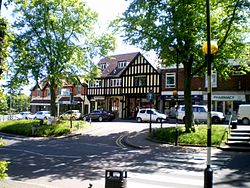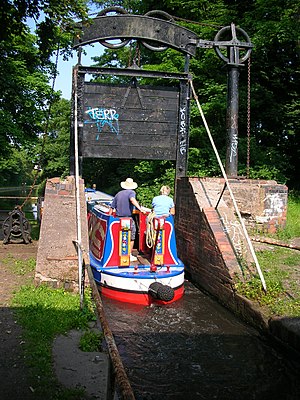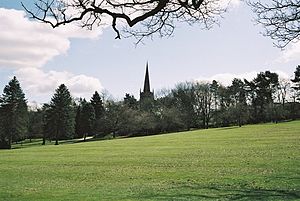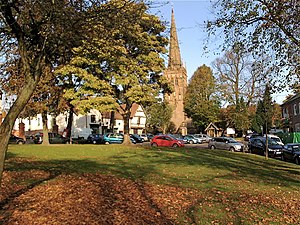Kings Norton: Difference between revisions
Created page with "{{Distinguish|King's Norton, Leicestershire}} {{Infobox town |county=Worcestershire |latitude= 52.4072 |longitude= -1.9272 |population = 24,380 |census year=2011<ref>{{cite we..." |
No edit summary |
||
| Line 15: | Line 15: | ||
|picture caption=View of The Green | |picture caption=View of The Green | ||
}} | }} | ||
'''Kings Norton''' ( | '''Kings Norton''' (sometimes '''King's Norton''') is a town and ancient parish in northern [[Worcestershire]] that forms a suburb of [[Birmingham]]. | ||
==History== | ==History== | ||
Kings Norton derives its origin from the basic Early English ''Nor + tun'', meaning North settlement and belonging to or held by the king, when Kings Norton was the northernmost of the | Kings Norton derives its origin from the basic Early English ''Nor + tun'', meaning North settlement and belonging to or held by the king, when Kings Norton was the northernmost of the berewicks or outlying manors of [[Bromsgrove]]. Before 1066 these manors with many others in the Birmingham area had belonged to Earl Edwin, the Anglo-Saxon Earl of Mercia. When in that year a Viking army sailed up the [[River Humber]] to invade England, Edwin went to do battle, but was heavily defeated at the Battle of Fulford Bridge near [[York]]. King Harold arrived the next day, and after defeating the Vikings at the Battle of Stamford Bridge, immediately marched back south to be himself defeated at the Battle of Hastings. Edwin and his broken remnant of an army were unable go with him. Thus, after the Norman Conquest, when William punished Harold's supporters, Edwin was not amongst them and did not forfeit his lands. Two years later, however, Edwin revolted against William who confiscated his holdings to give as rewards to his followers. Bromsgrove and its berewicks he kept, with himself both as tenant-in-chief and manorial lord. Thus the manor became Kings Norton remained royal from Domesday until 1804. [http://billdargue.jimdo.com/placenames-gazetteer-a-to-y/places-k/kings-norton/] | ||
===Civil war=== | ===Civil war=== | ||
| Line 67: | Line 67: | ||
In 1999, the Pool Farm, Primrose and [[Hawkesley]] housing estates, collectively known as the 'Three Estates', were awarded a regeneration grant as part of the government's New Deal for the Community programme (NDC). The award of £50 million is designed to run over ten years. Unlike earlier government regeneration programmes, NDC is able to focus on issues such as health and employment as well as on housing. Following considerable consultation, a major rebuild of the estates is planned.<ref>[http://www.3estates.co.uk/newDeal/ 3 Estates: New Deal Projects]</ref> | In 1999, the Pool Farm, Primrose and [[Hawkesley]] housing estates, collectively known as the 'Three Estates', were awarded a regeneration grant as part of the government's New Deal for the Community programme (NDC). The award of £50 million is designed to run over ten years. Unlike earlier government regeneration programmes, NDC is able to focus on issues such as health and employment as well as on housing. Following considerable consultation, a major rebuild of the estates is planned.<ref>[http://www.3estates.co.uk/newDeal/ 3 Estates: New Deal Projects]</ref> | ||
A major redevelopment of the Wychall Farm estate, in the | A major redevelopment of the Wychall Farm estate, in the ancient parish of Northfield, to the west of Kings Norton, was started in 2001. The previous housing was built using a system build approach that had exceeded its projected life-span. Bromford Housing Association have led the redevelopment.<ref>[http://www.bromford.co.uk Bromford Housing Group]</ref> | ||
A large, new, private housing estate has also been built on the site of the former Monyhull Hall Hospital, just outside the boundary of Kings Norton ward. | A large, new, private housing estate has also been built on the site of the former Monyhull Hall Hospital, just outside the boundary of Kings Norton ward. | ||
Latest revision as of 18:04, 17 October 2020
- Not to be confused with King's Norton, Leicestershire
| Kings Norton | |
| Worcestershire | |
|---|---|
 View of The Green | |
| Location | |
| Grid reference: | SP049788 |
| Location: | 52°24’26"N, 1°55’38"W |
| Data | |
| Population: | 24,380 (2011[1]) |
| Post town: | Birmingham |
| Postcode: | B38 |
| Dialling code: | 0121 |
| Local Government | |
| Council: | Birmingham |
| Parliamentary constituency: |
Birmingham Selly Oak Birmingham Northfield Birmingham Hall Green |
Kings Norton (sometimes King's Norton) is a town and ancient parish in northern Worcestershire that forms a suburb of Birmingham.
History
Kings Norton derives its origin from the basic Early English Nor + tun, meaning North settlement and belonging to or held by the king, when Kings Norton was the northernmost of the berewicks or outlying manors of Bromsgrove. Before 1066 these manors with many others in the Birmingham area had belonged to Earl Edwin, the Anglo-Saxon Earl of Mercia. When in that year a Viking army sailed up the River Humber to invade England, Edwin went to do battle, but was heavily defeated at the Battle of Fulford Bridge near York. King Harold arrived the next day, and after defeating the Vikings at the Battle of Stamford Bridge, immediately marched back south to be himself defeated at the Battle of Hastings. Edwin and his broken remnant of an army were unable go with him. Thus, after the Norman Conquest, when William punished Harold's supporters, Edwin was not amongst them and did not forfeit his lands. Two years later, however, Edwin revolted against William who confiscated his holdings to give as rewards to his followers. Bromsgrove and its berewicks he kept, with himself both as tenant-in-chief and manorial lord. Thus the manor became Kings Norton remained royal from Domesday until 1804. [3]
Civil war
Kings Norton was the scene of a couple of minor episodes during the Civil War. In the first of these, a force led by Prince Rupert of the Rhine, numbering some 300, was resting on Kings Norton Green. There, they were surprised by a smaller group led by Lord Willoughby of Parham. A skirmish took place, in which fifty of Prince Rupert's men were killed, and twenty were taken prisoner. The Parliamentarian force lost twenty men. This took place on 17 October 1642.
In a later episode, Queen Henrietta Maria arrived in Kings Norton with an army of around 5,500 men that she had raised in Yorkshire. It is believed that she stayed the night in the Saracen's Head, while the army camped on land behind the church, now Kings Norton Park (giving rise to the modern road name "Camp Lane"). There is also a public house on this road named The Camp Inn.
Markets and fairs
In 1616, King James granted permission to hold markets and fairs at Kings Norton. Both the original fairs and the market eventually fell into disuse. At some later date, a mop fair began to be held on the Green on the first Monday of October. A mop fair was a hiring fair where people would go looking for employment. After the decline of hiring fairs, the mop became a village fête organised by the Round Table and raising money for local people. More recently, the Round Table handed over running the mop to a commercial fun fair. A new farmers' market was set up in 2005, operating on The Green once a month.
Industrialisation and expansion

In 1796, the Worcester and Birmingham Canal was built through Kings Norton, linking Birmingham to the River Severn. This was linked to the Stratford-upon-Avon Canal by Kings Norton Junction, allowing access to Stratford-upon-Avon and, more significantly, the Grand Union Canal. Just beyond the junction is a rare example of a guillotine lock used here as a stop lock.
Kings Norton, along with many of the small towns near Birmingham, expanded considerably in the 19th century with a railway link into Birmingham passing by the new Bournville factory just to the north. The town was incorporated into Birmingham in 1911 by the Greater Birmingham Act.
Urbanisation

During the 20th century, the area grew further with additional private and public housing. In October 1920, 25½ acres of land at Kings Norton (just below St Nicolas' Church) were purchased by the Birmingham Civic Society and afterwards presented to the city for the benefit of the citizens of Birmingham. The Society also designed and paid for the formal gardens, gates on the Pershore Road side and stone benches.
With the clearance of city centre slum housing, there was a pressing need for additional social housing in Birmingham. As part of this programme, the City Council built several new housing estates in Kings Norton, including the Wychall Farm and Pool Farm estates in the 1950s and the Primrose and Hawkesley estates in the 1960s and 1970s. These new estates occupied land that had previously been open farmland, most notably the area known as the Three Estates (Pool Farm, Primrose and Hawkesley), which lies mostly to the east of the Birmingham and Worcester canal and the A441 Redditch Road.
In the mid-1970s, a large housing estate featuring both private and social housing as well as a small shopping area (although many of the shops have long since closed), a public house, a primary school and a day centre was built on what was once the Kings Norton Golf Course and is often colloquially referred to as the 'Golf Course Estate'.
The Wychall Farm housing estate, which is in the ancient parish of Kings Norton, was developed by the city council during the 1950s, and also included Wychall Farm Primary School, for pupils aged 5–11 years, which opened in 1956.[2] However, the housing fell into increasing disrepair towards the end of the 20th century and by the summer of 2006 a demolition programme had begun on the estate, which will see 500 homes demolished to make way for a 350-home housing association development. Within three years, most of the demolition had been completed and some of the new homes were already occupied.[3]
Places of interest

St Nicolas' Church dates from the 13th century, and the spire dates from the 15th century.[4] In addition, the Green contains three later mediæval buildings from the 15th century: the Old Grammar School, the Saracen's Head and number 10 The Green. In the summer of 2004, two of these ancient buildings, the Saracen's Head and the Old Grammar School, were the winners of the BBC's Restoration competition and were awarded over £3 million towards the cost of major refurbishment. In 2006, planning permission was granted for the restoration of these buildings, and work started.
The Old Grammar School and Saracen's Head were reopened to the public in June 2008, and in December 2008 were renamed as Saint Nicolas Place.[5]
Transport
Modern Kings Norton lies on the A441 Pershore Road South, which runs between Birmingham and Redditch to the south. It also has a railway station on the Cross-City Line. The line of Icknield or Ryknild Street, a Roman road running northwards from Alcester via Metchley Fort in Edgbaston towards Sutton Coldfield and beyond, can be traced through the eastern edge of the district.
Buses run to Birmingham city centre every few minutes.
Industry
In 1918 and 1919 the Kings Norton Metal Company produced British one penny coins on contract from the Royal Mint, these pennies are identified by a mintmark to the left of the date of "KN". The company also produced coins for other countries. This company, many years later after many partnerships and takeovers, was in part to become the Birmingham Mint located at the site of the Heaton mint in Icknield Street, Birmingham 18.
Kings Norton is home to the world-famous glass manufacturers Triplex (now part of Pilkington).
Redevelopment
A number of redevelopment projects have proved necessary because of the deteriorating quality of the social housing in Kings Norton.
In 1999, the Pool Farm, Primrose and Hawkesley housing estates, collectively known as the 'Three Estates', were awarded a regeneration grant as part of the government's New Deal for the Community programme (NDC). The award of £50 million is designed to run over ten years. Unlike earlier government regeneration programmes, NDC is able to focus on issues such as health and employment as well as on housing. Following considerable consultation, a major rebuild of the estates is planned.[6]
A major redevelopment of the Wychall Farm estate, in the ancient parish of Northfield, to the west of Kings Norton, was started in 2001. The previous housing was built using a system build approach that had exceeded its projected life-span. Bromford Housing Association have led the redevelopment.[7]
A large, new, private housing estate has also been built on the site of the former Monyhull Hall Hospital, just outside the boundary of Kings Norton ward.
Famous residents
- Brian Aherne, Oscar-nominated actor born in Kings Norton.
- Patrick Aherne, actor born in Kings Norton.
- Andy Akinwolere, BBC Blue Peter TV programme presenter, was educated here, at St Thomas Aquinas Catholic School
- The Revd W. V. Awdry, creator of Thomas the Tank Engine, was a curate at King’s Norton from late 1940 to 1946
- Reg Bunn (1905–1971), artist
- Neville Chamberlain, Lord Mayor of Birmingham 1915–1917 and subsequently Prime Minister 1937–1940, lived in King's Norton for most of his life, as did his wife Anne
- Roxbee Cox, Baron Kings Norton, aeronautical engineer
- Janet Parker (1938–1978), medical photographer and victim of smallpox
- George Dawson, non-conformist preacher and advocate of the Civic Gospel
- Thomas Hall, non-conformist preacher, pamphleteer, author of 'The loathsomeness of long hair', appointed to Kings Norton Parish in 1629
- Mick Harris, musician, best known for drumming in Napalm Death in 1985-1991; also engaged in a number of side-projects musically varying from jazz, death-grind to ambient industrial
- Alan Napier, actor, best known for playing the butler Alfred Pennyworth in the 1960s Batman television series
- Alan Nunn May, a physicist and a Russian spy, was born and lived the early part of his life in Kings Norton.
- Charles Piers Egerton Hall, who became one of the 50 executed and murdered by the Gestapo on the personal orders of Adolf Hitler on 30 March 1944 following "The Great Escape"
- Philip Stainton, actor born in Kings Norton.
- Enoch Powell, politician and Conservative MP/ UUP MP, Moved to King's Norton in 1918, where he lived until 1930.
References
- ↑ "Birmingham Ward population 2011". http://www.neighbourhood.statistics.gov.uk/dissemination/LeadKeyFigures.do?a=7&b=13689696&c=Kings+Norton&d=14&e=62&g=6361394&i=1001x1003x1032x1004&m=0&r=1&s=1450095300312&enc=1. Retrieved 14 December 2011.
- ↑ [1]
- ↑ [2]
- ↑ Douglas Hickman (1970). Birmingham. Studio Vista Limited.
- ↑ "Famous Saracen’s Head to lose its name". Birmingham Mail. http://www.birminghammail.net/news/birmingham-news/2008/11/17/famous-saracen-s-head-to-lose-its-name-97319-22274169.
- ↑ 3 Estates: New Deal Projects
- ↑ Bromford Housing Group